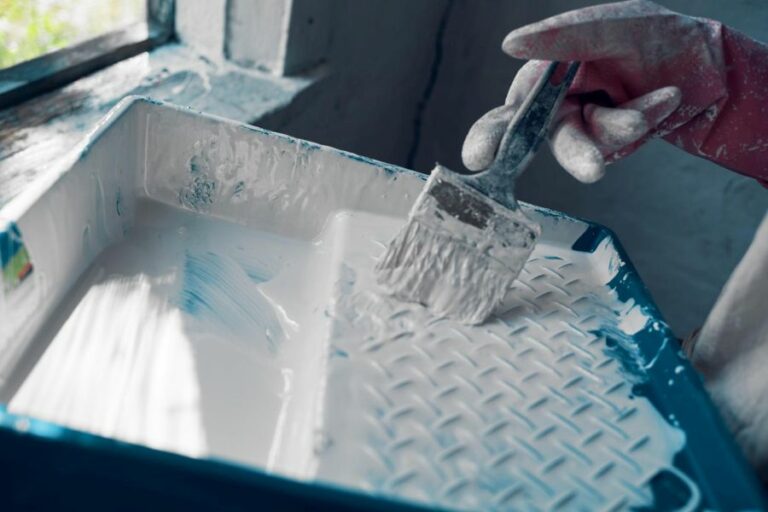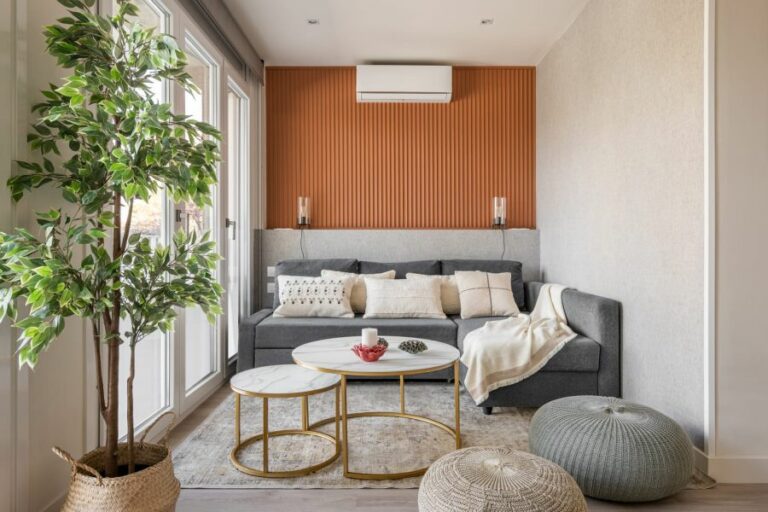Best Acrylic Paint For Walls, 25 Things You Should Know
Are you searching for the perfect acrylic paint to transform your walls into a canvas? I’ve got you covered. Choosing the best acrylic paint for walls is crucial to achieving that stunning finish and durability. Let’s delve into the specifics that make paint the ultimate choice for your home, ensuring you’ll achieve a long-lasting, impactful look that you will be proud of. Let’s get started!
Best acrylic paint for walls:>
The best acrylic paints for walls are water-based, versatile, quick-drying, and long-lasting. Top brands include Benjamin Moore, Sherwin-Williams, Valspar, and Behr. These paints offer excellent durability, coverage, color selection, and ease of application. Finishes range from matte to semi-gloss, based on the desired look and area usage. Proper surface preparation, quality tools, and correct application techniques are key to achieving a professional finish.

Ready to elevate your wall art game? Discover the top acrylic paint brands for walls and learn expert application tips to make your masterpieces pop. Read on to unleash your inner artist!
Contents
- 1 Top Acrylic Paints for Wall Decor
- 2 Is Acrylic Paint Suitable for Walls?
- 3 Techniques for Sealing Acrylic Paint on Walls
- 4 Drawbacks of Using Acrylic Paint on Walls
- 5 Comparing Wall Paint with Acrylic Paint
Top Acrylic Paints for Wall Decor
As a professional painter with years of experience, I can confidently say that finding the best acrylic paint for walls is an essential step when it comes to interior design and home decoration.
• What Makes Acrylic Paint Ideal for Walls
Acrylic paint is widely known for its versatility, quick-drying feature, and long-lasting finish. This water-based paint has several advantages over oil-based ones, including easier cleanup, lower odor, and reduced environmental impact.
- Durability and Longevity: Acrylic paint has excellent resistance to wear, tear, and exposure to environmental elements, making it an ideal choice for wall painting. It retains its color and sheen for years without fading, chipping, or peeling.
- Ease of Application: Acrylic paint can be applied easily with brushes, rollers, and sprayers on various surfaces like wood, metal, or masonry. Its adherence and smooth consistency lead to a smoother and more even finish.
- Quick Drying Time: The fast-drying nature of acrylic paint allows you to apply multiple coats within a shorter timeline.
- Easy Cleanup: Since acrylic paint is water-based, you can easily clean your brushes and equipment with soap and water.
• High-Quality Acrylic Paint Brands
In order to achieve a professional-looking finish on your walls, it is essential to invest in high-quality acrylic paint. Below are some of the top brands in the market today that I would personally recommend:
- Benjamin Moore: Regarded as one of the premier paint brands, Benjamin Moore offers a wide range of acrylic paints that are known for their durability, coverage, and rich color palette.
- Sherwin-Williams: Known for its exceptional quality and in-depth selection of colors, Sherwin-Williams has a variety of acrylic paints designed for residential and commercial projects.
- Valspar: Valspar is another well-known brand that offers a diverse range of acrylic paints with excellent coverage, easy application, and long-term durability.
- Behr: Renowned for its impressive color options and affordability, Behr has several lines of acrylic paints, including their popular Marquee and Premium Plus series, that cater to different project requirements and budget constraints.
• Selecting the Right Paint Finish
When it comes to choosing the best acrylic paint for walls, the paint finish is just as important as the color. The finish will determine the overall look and feel of your space, as well as the paint’s durability and ease of maintenance. Here are the most common finishes and their recommended uses:
- Matte or Flat: Ideal for ceilings or low-traffic areas where less sheen is desired. This finish provides the best coverage, but it’s less durable and harder to clean compared to others.
- Eggshell: Suitable for living rooms and bedrooms, an eggshell finish offers a subtle sheen and is more washable than flat paint.
- Satin: With a slightly higher sheen than eggshell, satin finish works well in high-traffic areas like kitchens, bathrooms, and hallways due to its easy-to-clean and moisture-resistant properties.
- Semi-gloss: Best used for trim, doors, and cabinets, semi-gloss paint offers a durable, easy-to-clean surface with a noticeable sheen.
• Tips for Proper Paint Application
Once you have selected the best acrylic paint for your walls, follow these tips to ensure a flawless and long-lasting finish:
- Surface Preparation: Before applying any paint, make sure to clean, repair, and prime the surface. Properly prepped surfaces ensure better adhesion and a smoother finish.
- Use Quality Tools: Select the appropriate brushes, rollers, and other equipment for your project. High-quality tools facilitate a more consistent application and help minimize brush marks and uneven texture.
- Thin Layers: Apply thin, even coats of paint rather than a single thick coat. This helps achieve a smoother finish and prevents a buildup of excess paint.
- Allow Adequate Drying Time: As tempting as it may be to apply the second coat soon after the first, waiting for the recommended drying time between coats will result in a more professional-looking outcome.
- Proper Technique: Use a combination of vertical and horizontal strokes to achieve even coverage of the paint while avoiding streaks or lap marks.
By following these guidelines and selecting the best acrylic paint for your walls, you can achieve a beautiful and long-lasting finish. For additional information on the selection and application of acrylic paint, you may refer to resources provided by the Paint Quality Institute.
Brand | Product | Description |
|---|---|---|
Benjamin Moore | Regal Select Interior Paint | Acrylic paint with excellent coverage, durability, and washability |
Behr | Premium Plus Interior Paint & Primer | A combination of paint and primer in one, providing excellent adhesion and finish |
Sherwin-Williams | Emerald Interior Acrylic Latex Paint | High-quality paint with superior durability, stain resistance, and coverage |
Glidden | Essentials Interior Paint | An affordable option that provides good coverage and easy application |
Valspar | Signature Interior Paint | A versatile paint that delivers smooth application and long lasting finish |
Is Acrylic Paint Suitable for Walls?
Acrylic paint is a versatile and popular medium for artists, craft hobbyists, and DIYers. It is known for its quick-drying properties, vibrant colors, and ease of use.
• Advantages of Using Acrylic Paint on Walls
There are several advantages to using acrylic paint on walls:
- One main advantage is its quick-drying time. Acrylic paint dries faster than other mediums, such as oil or latex paints, making it easier to finish painting projects quickly without having to wait long periods for the paint to dry.
- Acrylic paint is water-based, which means it can be easily thinned using water and is non-toxic. This makes it an environment-friendly option for painting walls.
- Acrylic paint is durable and resistant to harsh conditions, such as temperature changes, UV exposure, and moisture. This makes it a suitable choice for areas exposed to different environmental conditions.
- The vast color range and finish options are other advantages. Acrylic paint comes in a wide variety of colors and finishes, allowing homeowners to get creative with their wall designs and colors.
• Disadvantages of Using Acrylic Paint on Walls
Despite its advantages, there are also some disadvantages to using acrylic paint on walls:
- Acrylic paint can be more expensive than other paint types, such as latex or oil-based paints, making it a more costly option for large wall painting projects.
- The quick-drying property of acrylic paint can be a disadvantage when blending or working on intricate designs. This characteristic often requires skilled hands and quick decision-making to avoid mistakes and achieve the desired finish.
- Acrylic paint may not adhere well to certain wall surfaces, such as bare drywall, glossy surfaces, or surfaces with a high level of moisture. It’s essential to prime these surfaces to ensure proper adhesion and prevent peeling.
• Preparing Walls for Acrylic Paint Application
Before applying acrylic paint to walls, it’s important to prepare the surface properly. Here are some steps to take:
- Clean the wall surface. Remove dust, dirt, and grease from the surface using a mild detergent and water. Rinse the wall with clean water and let it dry completely.
- Apply a primer. Primer serves to seal the wall, provide a smooth surface for the paint, and improve adhesion. Use a primer specifically designed for use with acrylic paint to ensure compatibility. Allow the primer to dry according to the manufacturer’s directions.
- Repair any surface imperfections. Fill any holes, cracks, or dents on the wall with appropriate patching materials, then sand the repaired areas smoothly. Applying primer to the repaired areas can help hide any imperfections and provide an even surface for the paint.
• Application Techniques for Acrylic Paint on Walls
Here are some application techniques to consider when using acrylic paint on walls:
- Use a high-quality paintbrush or roller. Choose a brush or roller that is designed for use with acrylic paint. Synthetic bristles are generally recommended for acrylic paint, as natural bristles may absorb too much paint.
- Apply thin, even coats of paint. Acrylic paint is less likely to sag, run, or show brush strokes if applied in thinner layers.
- Allow each coat to dry completely. Although acrylic paint dries quickly, it is essential to let each coat dry before adding the next. This can help prevent flashing or uneven sheen in the final finish.
- Consider using an acrylic paint extender. Adding a paint extender to your acrylic paint can slow the drying time, making it easier to create blended effects or work on intricate designs.
- Seal the final paint layer with a protective clear coat. Applying a clear, acrylic-based sealer can protect the final paint job and improve the durability of the finish.
• Can Acrylic Paint Be Removed from Walls?
If you need to remove acrylic paint from a wall, it is possible but may require some effort. The use of rubbing alcohol, acetone, or a paint stripper specifically designed for acrylics can help lift the paint from the surface.
Always test in an inconspicuous area first, as these chemicals can damage the underlying surface.
• Final Verdict
In conclusion, acrylic paint can be used on walls, providing a quick-drying, durable, and versatile option for painting interior surfaces. However, the cost, potential adhesion issues, and skill required to achieve desired finishes may be considered disadvantages.
With proper preparation, application techniques, and finishing, acrylic paint can offer a long-lasting and creative finish for walls.
For more information on using acrylic paint on walls, the Liquitex website provides a range of educational materials and resources.
Techniques for Sealing Acrylic Paint on Walls
Sealing acrylic paint on walls is an essential step if you aim to achieve a long-lasting, durable, and professional-looking finish. Without proper sealing, acrylic paint is susceptible to moisture, dust, and other environmental factors that may cause it to fade, crack, or peel over time.
• Why Seal Acrylic Paint on Walls?
Acrylic paint is flexible and water-resistant, making it an optimal choice for painting walls. However, sealing the paint offers additional protective layers to safeguard your work from the elements like sunlight, humidity, and pollutants, ensuring that your artwork remains vibrant and fresh over time.
Moreover, a sealer offers an even surface, making it easier to clean your wall without worrying about damaging your design.
• Selecting the Right Sealer
Choosing the right sealer is crucial to attaining a professional finish. There are several types of sealers available, each with their unique properties and applications. The two most common types of sealers used for acrylics on walls are varnish and polyurethane.
– Varnish
Varnish is a popular choice for sealing acrylic paint on walls due to its durability and compatibility with the medium. It offers a clear, hard, and protective finish to your work, preserving its vibrancy and enhancing its color.
Varnish is available in gloss, satin, and matte finishes. You can learn more about varnishes on the Golden Paints website.
– Polyurethane
Polyurethane is another option for sealing acrylic paint on walls. It provides a more robust and durable finish than varnish and is suitable for high-traffic areas. However, it might take longer to dry, and some may turn yellow over time.
Polyurethane is available in water-based and oil-based formulas, and it’s essential to choose the right type based on your paint type and personal preferences.
• Preparing the Wall
Before applying the sealer, ensure that the wall is clean, dry, and free from dust, dirt, or grease. This is a critical step, as the presence of grime can result in an uneven and unprofessional finish.
Additionally, make sure the paint is fully dry and has cured for at least 24-48 hours, as applying a sealer over wet paint may lead to streaks and undesired results.
• Applying the Sealer
Once you have selected the right sealer and prepared the wall, follow these steps to seal your acrylic paint on walls:
– Step 1: Stir the Sealer
Before applying the sealer, gently stir the content without causing bubbles or vigorous agitation, as it may lead to unwanted textures on the final finish.
– Step 2: Apply the Sealer
Using a wide, flat brush or a foam brush, apply a thin, even coat of sealer onto the painted wall. Be careful not to brush over the same area repeatedly, as it may cause streaks or lifting of the underlying paint. Instead, use long and smooth brush strokes, working from the top to the bottom of the wall.
– Step 3: Allow the Sealer to Dry
Allow the applied sealer to dry completely, following the manufacturer’s recommended drying time. It’s crucial not to rush this process, as applying additional coats or subjecting the wall to humidity or contaminants before the sealer dries may result in a poor and unprofessional finish.
– Step 4: Apply Additional Coats
For enhanced protection and durability, you may want to apply additional coats of sealer to your wall. Ensure that you allow each coat to dry fully before applying the next one. Typically, two to three coats should suffice for most applications.
– Step 5: Clean Your Brushes
After applying the sealer, promptly clean your brushes with the appropriate solvent. For water-based sealers, use soap and water, while turpentine or mineral spirits are suitable for oil-based sealers.
• Tips for a Professional Finish
Following these tips will help you achieve a professional and durable finish when sealing acrylic paint on walls:
- Choose the right type and finish of the sealer according to your artwork, wall surface, and intended longevity.
- Always test the sealer in a small, inconspicuous area before applying it to the entire wall to ensure compatibility, desired finish, and drying times.
- Avoid working in direct sunlight or in extremely humid environments, as it may negatively affect the curing and drying of the sealer.
- Keep a consistent brush stroke direction and avoid overworking an area to prevent streaks and unevenness.
- Ensure proper ventilation when working with sealers, particularly oil-based polyurethanes, to minimize exposure to potentially harmful fumes.
By following these guidelines, you can confidently seal acrylic paint on walls, ensuring that your artwork remains vibrant and protected for a long time.
Step | Instructions |
|---|---|
1 | Clean the wall surface thoroughly. |
2 | Apply a primer to the wall surface. This will help the paint adhere better and provide a smoother finish. |
3 | Choose a high-quality acrylic paint and apply it to the wall using a brush or roller. Use even strokes and cover the entire surface. |
4 | Allow the paint to dry completely. This usually takes a minimum of 24 hours, but it may be longer depending on the paint and environmental conditions. |
5 | Apply a sealer to the painted surface. This can be a water-based or solvent-based sealer, depending on the desired finish and compatibility with the acrylic paint. Follow the manufacturer’s instructions for application. |
6 | Allow the sealer to dry completely, typically at least 24 hours, before touching or hanging anything on the wall. |
Drawbacks of Using Acrylic Paint on Walls
Acrylic paint, a popular choice for artists and DIY enthusiasts, has become increasingly popular as interior wall paint due to its versatile nature and ease of use. However, like any other product, it also has its drawbacks.
• Lower Durability
While acrylic paint may be known for its versatility and quick drying, it falls short when it comes to durability. Compared to traditional oil-based or latex paints, acrylic paint is more susceptible to peeling, chipping, and scratching over time.
This can lead to unattractive walls that require more frequent touch-ups or repainting, costing you more time and money in the long run.
• Inadequate Coverage
Acrylic paint tends to have a lighter, more translucent quality, which might be great for certain painting techniques but can be a disadvantage when it comes to providing ample coverage on walls.
It may necessitate multiple coats to achieve the desired level of opacity, particularly when painting over a darker undercoat. This can result in increased paint costs, as well as more time spent on your painting project.
• Difficulty in Creating Smooth Finishes
Creating a smooth, even finish with acrylic paint can be a challenge, particularly for beginners. Due to the quick-drying nature of acrylic paint, it can be difficult to blend and manipulate on the wall, making it harder to achieve a seamless finish.
Additionally, brush strokes are more visible with acrylic paint, so you might have to spend extra time sanding and refinishing the surface to achieve the desired look.
• Less Resistance to Moisture and Stains
Acrylic paint is not as water-resistant or stain-resistant as other paint types, such as oil-based or latex paints. In high-moisture areas, like bathrooms or kitchens, acrylic paint can quickly become damaged or discolored, necessitating touch-ups or even repainting.
Similarly, acrylic paint on walls is more prone to staining, and the removal of stubborn stains may involve sanding and repainting the affected area.
• Limited Color Choices
While acrylic paint does come in a wide variety of colors, it does not have the same range of color options as latex or oil-based paints. So if you want a more diverse selection of colors, you may be better off choosing a different type of paint.
Additionally, acrylic paint colors are not as consistent across different product lines as is the case with latex and oil-based paints. Therefore, finding the perfect color can be more challenging with acrylic paint.
• Environmental and Health Concerns
Due to the synthetic and chemical nature of acrylic paint, it can emit harmful VOCs (volatile organic compounds) into the air during the painting process and even after the paint has dried.
These compounds can cause respiratory issues, headaches, and other health conditions, particularly in sensitive individuals. When using acrylic paint, proper ventilation should be ensured during and after painting to limit exposure to VOCs.
• Tips for Overcoming the Disadvantages of Acrylic Paint on Walls
Just because acrylic paint has disadvantages doesn’t mean it’s not a suitable option for some projects. Here are some tips to help you navigate the potential pitfalls:
- Use high-quality acrylic paint that is specifically designed for walls or interior surfaces. This will help ensure better coverage, durability, and a smoother finish.
- Invest in a good set of painting tools, including brushes, rollers, and a paint tray. This will help you create a smooth finish and minimize visible brush strokes.
- Be sure to properly prepare your walls before painting, including cleaning, sanding, and priming.
- Choose a lighter or more neutral color for best coverage and blending, and only use darker colors in smaller accent areas.
- Ensure proper ventilation during and after painting to minimize exposure to harmful VOCs.
- Consider using an acrylic-latex blend for a middle ground between the benefits of acrylic and latex paint.
In conclusion, while acrylic paint on walls might not be the best choice for everyone, knowing its disadvantages can help you determine if it’s right for your specific project.
Armed with this knowledge, you can either choose an alternative paint type or take the necessary steps to overcome the drawbacks of acrylic paint on walls.
For more information on choosing the right paint for your project, consult resources provided by reputable organizations like the United States Environmental Protection Agency.
| Disadvantage |
|---|
| Fades in sunlight (UV exposure) |
| Not as durable as oil-based paints |
| Less resistant to stains and chemicals |
| Dries quickly, making it difficult to blend or make adjustments |
| Can cause streaking or brush marks if not applied properly |
| Not as moisture-resistant as other paint types |
| Some low-quality acrylic paints may contain carcinogens or toxins |
Comparing Wall Paint with Acrylic Paint
When it comes to painting projects, choosing the right type of paint is crucial to achieving the desired results. Two popular types of paint are wall paint and acrylic paint. But are they different from each other?
• Composition of Wall Paint and Acrylic Paint
– Wall Paint
Wall paint, also known as latex or water-based paint, is a versatile type of coating largely used for interior and exterior house decoration. It is made up of pigment, binder, and water.
The primary binder in wall paint is a combination of acrylic, vinyl, and other polymers, which helps the paint adhere to the surface and offers durability.
– Acrylic Paint
Acrylic paint is a water-based paint made predominantly from pure acrylic resin, which acts as a binder. It also contains pigment and water but may have additional additives to enhance specific properties like finish, drying time, or texture.
Acrylic paint is usually found in two qualities: artist or craft grade. It is widely used in art projects and offers flexibility and excellent color saturation when applied.
• Key Differences Between Wall Paint and Acrylic Paint
– Purpose and Application
Wall paint is specifically designed for large-scale home improvement projects, focusing on coverage and durability. It is suitable for indoor and outdoor applications on various surfaces like walls, ceilings, and sidings.
Wall paint is available in different sheens like flat, eggshell, satin, semi-gloss, and gloss, providing different aesthetics and protections.
Acrylic paint, on the other hand, is tailored for art projects, offering versatility and blending capabilities. It is ideal for creating fine details or mixed media artworks on surfaces like canvas, paper, wood, and metals. Acrylic paint usually dries to a semi-gloss finish but can be altered using additional mediums.
– Durability and Finish
Wall paint is formulated to withstand daily wear and tear, as well as exposure to the elements when used for exteriors. It usually contains a higher percentage of binder, which strengthens the paint film and improves adhesion to surfaces.
The sheen of wall paint affects its durability, with glossier finishes being more resistant to stains and easier to clean.
Acrylic paint is generally less durable than wall paint, as it is designed for artistic purposes rather than daily exposure to wear. However, some artist-quality acrylic paints are formulated with higher pigmentation and better-quality binders, providing higher adhesion and stability.
These can be sealed with varnishes or protective coatings for added durability.
– Color Range and Customization
Wall paint typically comes in premixed colors, with extensive color palettes available to consumers. Many retailers also offer color-matching services, allowing you to create a custom shade.
Acrylic paint has a vast assortment of premixed colors, but artists can create an infinite range of hues and tones by mixing them. The color saturation in acrylic paint is generally richer than in wall paint due to higher pigment loads.
• How to Choose the Right Paint for Your Project
When deciding between wall paint and acrylic paint, consider the following factors:
- Application: If you’re working on a home improvement project, wall paint is the recommended choice for its applicability, durability, and aesthetic versatility. For art projects or crafts, opt for acrylic paint due to its better blending and color saturation capabilities.
- Substrate: Check the compatibility of the paint with the surface you plan to apply it to. Some wall paints may not adhere well to certain materials, while acrylic paint can be more versatile when paired with appropriate mediums or sealers.
- Budget: Wall paint is generally more cost-effective when covering large areas, as it is formulated for broader applications. Acrylic paint can be pricier, especially those of artist-grade quality, due to the higher cost of pigments and binders.
- Drying Time and Working Properties: Acrylic paint dries quickly, allowing artists to work in layers without waiting for long periods. Wall paint may require longer drying times between coats, but it offers a longer working time, enabling corrections or adjustments during application.
In conclusion, wall paint and acrylic paint are indeed different, each serving a specific purpose with unique properties. It is essential to evaluate your project’s requirements and choose the paint accordingly.
The information provided in this article, combined with reliable resources, will help you make an informed decision for your painting needs.







